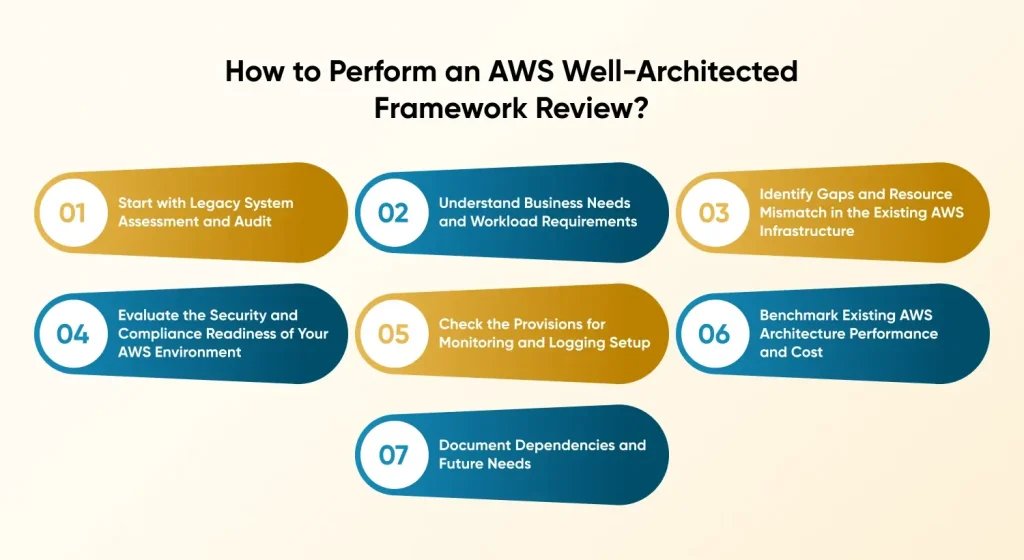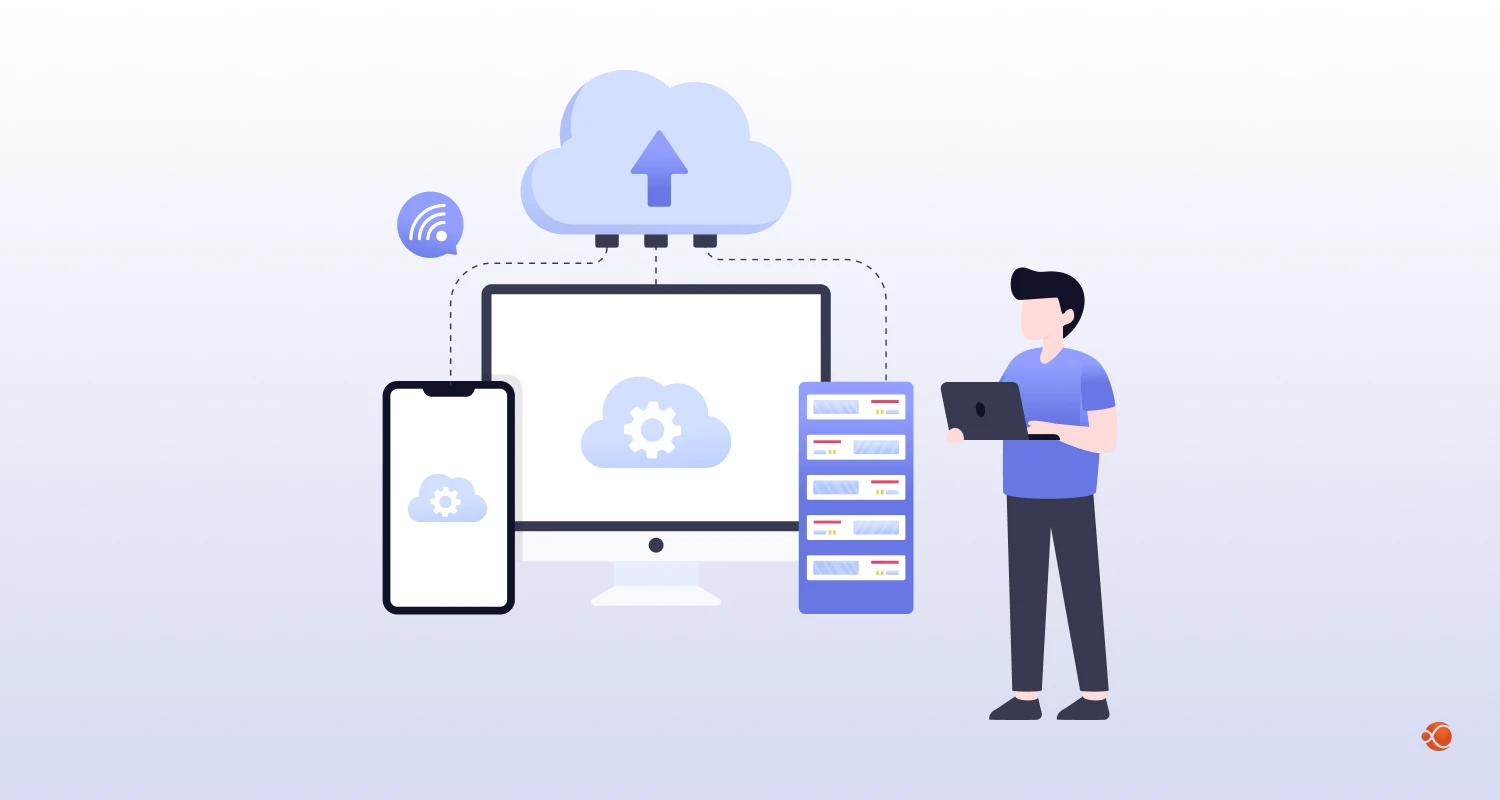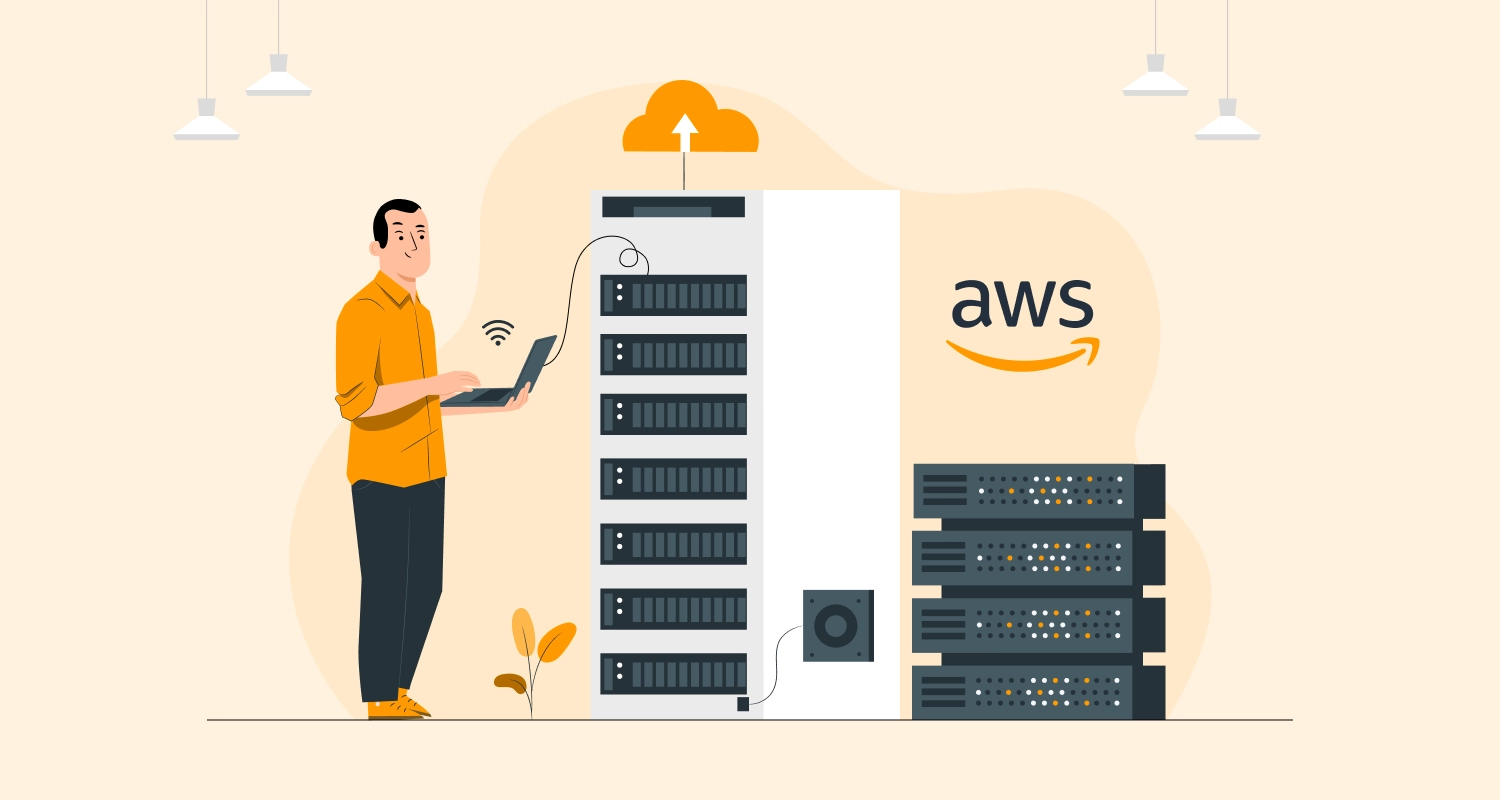Quick Summary: Are you an IT leader, cloud architect, or DevOps engineer looking to reduce costs, improve performance, and secure your cloud setup? This guide shows how AWS architecture optimization services can help you get the most out of your AWS environment, efficiently and effectively.
Cloud computing has revolutionized the scale at which enterprises operate, innovate, and compete these days. With so many big players like Google Cloud Platform, Microsoft Azure, and even AWS Cloud, whole enterprises are operating on these large-scale business environments for streamlining their operations and automating many manual processes.
But does simply moving to a cloud platform guarantee success? No, while these advanced cloud computing platforms have immense capabilities, they still need to be fine-tuned to your organizational needs, to unlock their true potential. Today, we will be looking at the benefits of AWS architecture optimization services. As highlighted in a recent market report, AWS has amassed 4.19M buyers with a major customer base in LATAM, AMER, EMEA, and APAC markets.
Today we will explore how AWS architecture optimization is enabling digital transformation in enterprises, and how we can optimize AWS infrastructure for different business needs.
What is AWS Architecture Optimization?
AWS Architecture optimization is a conscious effort of utilizing AWS best practices and tools for designing and building a cost-effective, highly-secure, scalable and reliable AWS ecosystem. The primary idea is to take all the ingredients Amazon Web Services (AWS) environment has to offer, filter out what’s needed and what’s not, and fine-tune the selected tools and best practices to match unique business requirements.
Why is it Important To Optimize AWS Infrastructure?
As we already discussed, just migrating to AWS is not enough. Without proper AWS architecture optimization services, most cloud tools remain bloated, expensive, and underutilized. You might already have some AWS resources as a part of your enterprise web application development, but if they aren’t optimized, chances are, you are paying for idle resources, facing unpredictable latency, or exposing your systems to concerning security gaps, without ever realizing it.
Key Business Outcomes of AWS Optimization:
- You spend less by right-sizing instances and automating scaling
- Your systems perform better by reducing bottlenecks
- You stay compliant and secure with updated configurations and monitoring
- And your architecture grows with your business, not against it
What are the Key Components of Future-Ready AWS Cloud Optimization?
To optimize AWS infrastructure, it is important to understand what you’re trying to achieve with AWS optimization services. The components of a successful and beneficial AWS well-architected framework are:
Cost Optimization
AWS cost optimization is not just about spending less, it’s about being smart about your spendings. If you are wondering how to keep AWS cost down, it involves best practices like right-sizing compute resources, using Reserved or Spot instances where needed, eliminating idle assets, and using popular AWS tools like AWS Cost Explorer, Trusted Advisor, and Budgets. This main purpose is to reduce waste without affecting performance.
Performance Optimization
One good thing and overwhelming thing about AWS is, it provides a plethora of options. You need to hire AWS developers who have enough experience and in-depth understanding of the AWS ecosystem, to know how to select the right instance types, optimize network throughput, use caching layers such as CloudFront or ElastiCache, and balance loads effectively.
Security and Compliance
One of the most painstaking and yet overlooked aspects of any AWS enterprise app development services is often misconfigured resources. This results in heavy costs and bills which makes the false perception of cloud computing being an expensive choice for most businesses. To truly optimize AWS architecture for security and compliance, skilled AWS teams focus on implementing IAM (Identity and Access Management) policies, ensuring data encryption, setting up security groups, and ensuring compliance with industry standards like SOC2, HIPAA, and GDPR.
Scalability and Reliability
The success of any AWS architecture optimization can be defined by how easily your architecture can grow with your business. This means setting up auto-scaling, distributing workloads across different availability zones, using multi-region failover setups, and much more technicalities that AWS has to offer. Develop a app using AWS with reliability engineering to ensure systems stay functional under stress or failure.
Operational Excellence
Last, but not the least, realize that AWS architecture optimization is a continuous process and not a one-time effort. Make sure to work with a dedicated AWS team that knows how to implement CI/CD pipelines, use Infrastructure as a Code, centralize logging and monitoring, and automate responses to system events. For any effective AWS architecture optimization services, the operations need to be predictable, repeatable, and measurable.
How to Perform an AWS Well-Architected Framework Review?

We have clearly defined the need and the benefits of optimizing AWS cloud architecture, but before you go looking to optimize your existing infrastructure, take a moment to understand what’s already in place. Most inefficiencies stem from outdated setups, mismatched resources, or cloud infrastructure that may not align with current business needs. Here is a quick checklist for AWS Cloud assessment.
1. Start with Legacy System Assessment and Audit
- Gather information on your current AWS environment.
- Identify all active AWS services, resources, and configurations.
- Document usage patterns, resource dependencies, and deployment details.
- Highlight the outdated services that no longer serve their purpose.
- Evaluate which workloads still make sense in AWS, and if they need to be restructured for modern requirements.
2. Understand Business Needs and Workload Requirements
It is important to understand that different workloads require different treatments. When you divide the AWS architecture planning into different processes, you will be able to better handle them:
- Map out current AWS usage to specific business functions and goals.
- Define “performance” and performance metrics for each workload.
- Identify which parts of the infrastructure are mission critical vs nice-to-have.
- Perform a thorough cost-performance analysis with regards to business outcomes.
3. Identify Gaps and Resource Mismatch in the Existing AWS Infrastructure
Any effective AWS architecture optimization services is not just about optimizing under-utilized resources. It is also about identifying overspending areas and bringing them down to optimized amounts.
- Identify underused services and over-provisioned compute or storage instances.
- Evaluate cost vs value for each service you pay for.
- Check for scalability issues or flexibility constraints during peak loads.
- Identify services that are not elastic enough to support growth or handle cost spikes.
4. Evaluate the Security and Compliance Readiness of Your AWS Environment
It is very probable to leave security gaps in a hasty Amazon Web Services (AWS) architecture setup, especially when the teams move fast without a centralized cloud governance plan. Here is how to assess AWS security of your environment:
- Audit IAM roles, policies, and access control lists.
- Check for exposed S3 buckets, open ports, or overly permissive rules.
- Ensure all data is encrypted properly.
- Review the compliance alignment with standards like SOC2, HIPAA, and GDPR.
- Make use of AWES tools like AWS Config, GuardDUty, and Security Hub for continuous compliance insights.
5. Check the Provisions for Monitoring and Logging Setup
Any cloud optimization effort begins with setting up the right tools and methods to flag inconsistencies and anomalies in a system. Check if your existing infrastructure has the following:
- Ensure CloudWatch is configured to monitor performance, logs, and custom metrics.
- Confirm that CloudTrail is capturing all user and server-level activities.
- Assess the log retention strategy, what’s being stored, for how long, and what cost.
- Review alerts, and dashboards: are they useful or just noise?
6. Benchmark Existing AWS Architecture Performance and Cost
Once your infrastructure is mapped out and documented, you can now set up a benchmark. This carefully planned and strategically calculated benchmark will help assess the benefits of future Amazon Web Services (AWS) architecture optimization services.
Compare actual performance against pre-defined KPs on latency, uptime response and other metrics.
- Calculate the AWS infrastructure monthly cost per workload or per service.
- Identify services with a poor cost-to-value ratio.
- Use AWS Trusted Advisor, Cost Explorer, and Computer Optimizer for identifying quick wins.
7. Document Dependencies and Future Needs
You don’t optimize cloud computing platforms for a year, or two. This needs to be done with conscious understanding and effort to fulfil and prepare your AWS infrastructure for future scaling needs.
- Map out service interdependencies across different environments (dev, staging, production).
- Forecast workload changes like seasonal spikes, user growth, geographic expansion.
- Identify where automation, containerization, or serverless can help with future improvements.
- Capture technical debt or known limitations that might pose challenges in the future.

What are the key skills to look for when Hiring AWS Cloud Architect?
Hiring an AWS Cloud Architect is not as easy as finding AWS developers with knowledge of EC2 or S3. You need a dedicated team that can look at your cloud environment holistically, optimize it for cost, performance, and scale, all while keeping your primary business goals in focus. Here are some of the skills you should be looking for to hire AWS developers:
| Key Skill Area | What to Look For |
| AWS Services Expertise | Look for an AWS architect who has clarity on EC2, S3, Lambda, RDS, VPC, and IAM, not just on paper, but in real deployments. |
| Cloud Architecture Fundamentals | They should understand how to build for scale, high availability, and fault tolerance, especially across multiple regions. |
| DevOps and Automation | Ideally, they’ve built or managed CI/CD pipelines, written Infrastructure as Code using Terraform or CloudFormation, and automated common cloud tasks. |
| Programming & Scripting | You want someone who can script in Python, Node.js, or Bash when needed, and who’s comfortable working with JSON and YAML for infrastructure configuration. |
| Networking & Security | Expect a solid grip on VPC design, IAM policies, encryption, access controls, and the ability to build secure, compliant systems from the ground up. |
| Containerization & Orchestration | They should know how to manage Docker containers and work with ECS, EKS, or Fargate to orchestrate modern cloud-native workloads. |
| Serverless Architecture | Look for hands-on experience designing serverless solutions with Lambda, Step Functions, and API Gateway, especially in event-driven systems. |
| Database & Storage Optimization | A good architect will know how to choose between RDS, Aurora, and DynamoDB—and how to control costs using S3 tiering, backups, and data lifecycle policies. |
| Soft Skills | Beyond the tech, they should be able to explain decisions clearly, collaborate with teams, and connect infrastructure choices to real business goals. |
How to Optimize AWS Architecture for Enterprise-Scale Efficiency
Use AWS Cost Management Tools
If you want your AWS architecture optimization effort to yield results, understand how your cloud resources are being used and where the money is going. Cost management as we discussed earlier, is not only about reducing cost, but aligning spending with performance, usage, and business priorities.
AWS offers a suite of tools that give you visibility into resource usage, cost, and optimization opportunities. These AWS cost optimization tools can help you understand where your money is being spent, track trends, and make informed decisions. Some real world use cases can be identifying idle compute instances, underutilized storage, or unnecessary data transfer costs.
| Tool | Primary Purpose |
| AWS Cost Explorer | Analyze spending patterns, forecast future costs, and visualize historical usage. |
| AWS Budgets | Set custom cost or usage budgets and receive alerts when you approach limits. |
| AWS Trusted Advisor | Provides real-time recommendations to reduce cost, improve performance and security. |
| AWS Compute Optimizer | Suggests optimal instance types based on historical usage patterns. |
| AWS Cost and Usage Report (CUR) | Offers detailed billing and usage data for advanced analysis. |
| AWS Pricing Calculator | Estimate costs of proposed architectures before deployment. |
Optimize Compute Resources
Select the right compute options based on your workload. That means choosing between EC2, Lambda, or ECS depending on whether your needs are bursty, consistent, or container-based. Also, use auto scaling groups to automatically adjust capacity. Switching from on-demand to reserved or spot instances where appropriate can also bring major savings.
Automate Repetitive Tasks
Automation reduces human error and saves time. Use AWS CloudFormation for infrastructure as code, set up Lambda functions for event-based workflows, and implement CI/CD pipelines with tools like CodePipeline or CodeBuild. The more your infrastructure can manage itself, the more resilient and efficient it becomes.
Follow the AWS Well-Architected Framework
This framework is more than just documentation. It’s a set of five pillars—operational excellence, security, reliability, performance efficiency, and cost optimization, that helps you build a stable and scalable AWS environment. Regular Well-Architected Reviews can uncover architectural flaws before they become business risks.
Tune Your Data Architecture
Store, access, and move your data in smarter ways. You can make use of Amazon S3 for cost-effective storage solutions, Amazon RDS or Aurora for optimizing transactional databases, and also Redshift for analytics purposes. Set up lifecycle rules and choose storage tiers wisely. This will help automatically transition or archive older data.
Continuously Monitor and Improve
Monitoring isn’t optional. Use CloudWatch for logs and metrics, AWS X-Ray for tracing, and third-party tools if you need more advanced observability. Set up alarms to catch anomalies early. More importantly, treat monitoring data as feedback for ongoing optimization rather than a one-time audit.
Stay Current with AWS Innovations
AWS evolves fast. Keeping up with new instance types, services, and cost-saving features can give you a major edge. Subscribe to AWS blogs, join webinars, or use AWS Skill Builder to keep your team sharp. Sometimes, small architectural tweaks based on new offerings can lead to big improvements.
Apply AWS Best Practices for Enterprise Security
Use IAM roles and policies wisely, enable MFA, encrypt data at rest and in transit, and use services like GuardDuty and Inspector for continuous threat detection. Make sure your VPCs, subnets, and security groups are properly configured to limit exposure.
Improve Performance Where It Matters Most
Find out where latency is coming from and which components are underperforming. You can use Amazon CloudFront to speed up content delivery, turn on caching wherever it makes sense, and use read replicas or sharding to improve database performance. You can also spread workloads across different Availability Zones or Regions to cut down on delays for users.
Think Sustainability
AWS already operates with a strong focus on sustainability, but you can go further by right-sizing instances, scheduling downtime for non-production environments, and choosing regions powered by renewable energy. A leaner, greener architecture often goes hand in hand with better performance and lower cost.
What are some Real World AWS Architecture Optimization Examples
GE Vernova: Saving Over $1 Million Through Rightsizing and Automation
GE Vernova is a major player in energy technology. They were struggling with something that hit most big companies, their cloud bills were out of control. The problem wasn’t complicated: they had tons of AWS resources just sitting there unused, and others that were taking up more space than they were providing returns.
How GE Vernova Optimized Their AWS Architecture?
- Used AWS Computer Optimizer to rightsize underutilized EC2 instances
- Implemented automated shutdowns for non-production environments
- Enforced lifecycle policies for temporary or redundant resources
- Used AWS Budgets to flag spending thresholds across teams
- Standardized infrastructure automation using CloudFormation
SmartNews: Cut Workload Costs by 50% and Tripled ML Inference Speed
SmartNews is a mobile-first media company with a customer base of millions globally. They were facing cost and performance issues with their machine learning infrastructure. The AWS engineering team helped them by migrating a large share of their compute workload to Services Spot Instances tool.
How SmartNews Optimized Their AWS Architecture?
- Shifted 70% of compute-heavy workloads to AWS Spot Instances
- Migrated machine learning inference to AWS Graviton2 and Graviton3 processors
- Optimized architecture for event-driven compute scaling
- Used CloudWatch metrics to monitor and improve performance bottlenecks
- Applied multi-region deployment strategies for global latency reduction
Blynder: Cutting 65% in Storage Costs Across 18 Petabytes of Assets
Blynder is a digital asset management SaaS platform. It stores over 175 million media files, making up for an enormous storage size of 18 PB, in Amazon S3. Their data access setup wasn’t working as it should, and storage costs started piling up fast. Once they switched to intelligent data tiering, they brought those costs down without messing with access to the files people used most.
Blynder AWS Architecture Optimization Strategy:
- Activated Amazon S3 Intelligent-Tiering for automatic cost-efficient storage
- Audited data access patterns to classify high- vs. low-frequency files
- Created automated transitions to Glacier tiers for cold data
- Removed redundant copies using S3 Lifecycle Policies
- Monitored cost impact using AWS Cost Explorer and detailed usage reports
Final Words
Moving to the cloud is only taking the first step towards benefiting from AWS deployment and architecture offerings. Real value comes from optimizing your AWS environment for performance, cost, uptime, scalability and other business goals and needs of a scaling enterprise. You need to realize that AWS architecture optimization is not a one-time process, and should be a part of your operating mindset.
If your current cloud setup feels expensive, underutilized, or simply chaotic, it is not a lost cause. It is an opportunity with the right AWS implementation and optimization partners.
FAQs on AWS Architecture Optimization Services
Why Is AWS Architecture Optimization Important for Modern Enterprises?
AWS architecture optimization ensures enterprises maximize their cloud investment by eliminating waste, improving performance, and enhancing security. Without proper optimization, companies often overpay for unused resources while experiencing poor system performance and potential security vulnerabilities.
How Can Enterprises Benefit From the AWS Well-Architected Framework?
The AWS Well-Architected Framework gives businesses a clear set of best practices across five key areas: operational excellence, security, reliability, performance, and cost savings. It helps companies build cloud systems that are not only secure and efficient but also flexible enough to grow with the business.
How Does AWS Cost Optimization Work?
AWS cost optimization is about making smarter use of your cloud resources. It means choosing the right amount of computing power, shutting down anything you’re not using, and saving money with options like Reserved and Spot Instances. Tools like Cost Explorer and Trusted Advisor make it easier to see where your money is going and help you make changes based on how your systems are actually being used.
Can AWS Architecture Optimization Reduce Cloud Spending?
Yes, optimizing your AWS architecture can cut cloud costs by 30 to 50 percent. This happens by removing unnecessary resources, using the right instance types, and setting up systems that automatically scale with demand. At the same time, companies often see better performance and reliability, so it’s both a cost-saving and performance-improving move.







